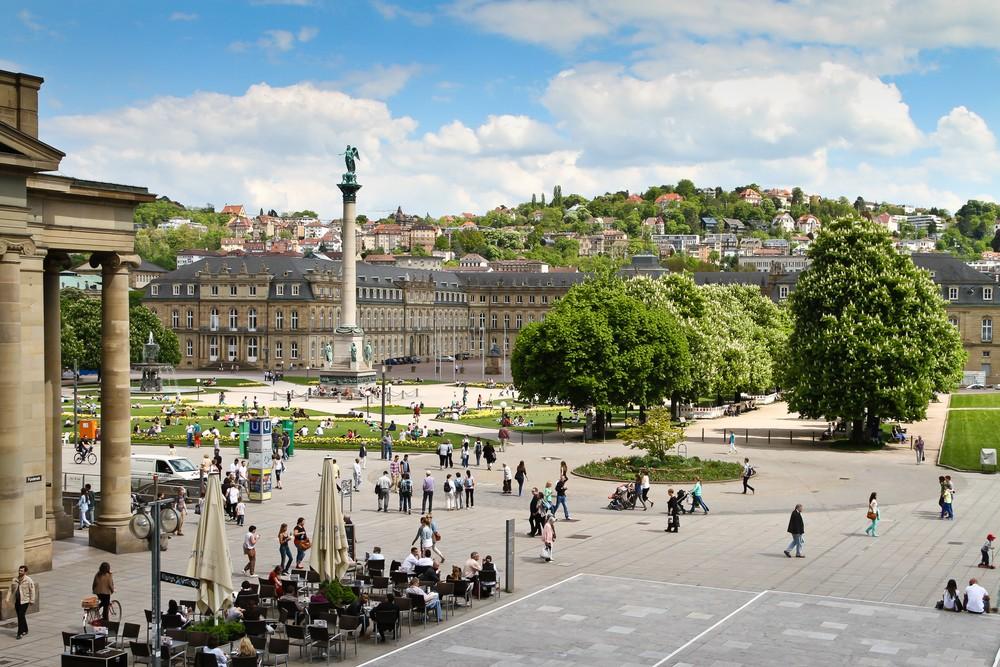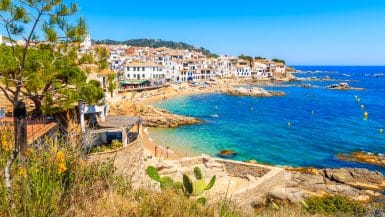Stuttgart’s location in a valley basin alone is worth seeing. The half-height streets offer an impressive overview of the city centre. For decades, the city, which nestles picturesquely like a shell in a cauldron-shaped valley, had to struggle with its reputation. She was considered hard-working, clean… and terribly boring. In the center of Stuttgart 20 years ago, tram trains were still jammed for a long time and cars chased pedestrians. Today, trees grow here, fountains splash, street musicians play and pavement painters show their skills. The city fathers have come up with a lot of ideas. The Königsmeile invites you to take a leisurely stroll without car or rail traffic. On mild days, when the numerous restaurants and pubs are well attended, a Mediterranean cheerfulness can be felt.
Monarchical splendour – between modern times and modernity
While everything in the residential city of the young kingdom was initially designed for the presentation of monarchical splendour, industry gradually took over the scepter.
For the entrepreneurial paradise on the Neckar, the location factors are almost ideal. Two universities, six academies and colleges as well as Fraunhofer and Max Planck Institutes strengthen Stuttgart’s leading position as a high-tech location.

Stuttgart is the economic heart of the “model state” Baden Württemberg. Names such as Daimler-Benz, Bosch and, last but not least, Porsche stand for concentrated industrial power in the region. The state capital is one of the most important economic centres in Germany. Well-known large companies and a large number of world-renowned, medium-sized companies shape the image of the high-tech region.
Is that the only thing that distinguishes Stuttgart? At first glance, they are certainly noble cars and tricky high-tech. But also – and this is far too often overlooked – a rich cultural landscape. Almost all epochs of European art history have left their mark here.
An idea of the lives of the people who lived here often only becomes apparent at second glance. You can still find them in the city, the squares and rows of houses, the bridges and corners that ensnare visitors with homely cosiness.
Leafing through the history book: According to tradition, Stuttgart did not come into the light of history until around the year 950. At that time, Duke Liutolf of Swabia is said to have established a stud farm in a valley extension of the Nesenbach. Over time, a settlement formed around this “Stoutengarten”. Well into the Middle Ages, today’s capital of Baden-Württemberg stood in the shadow of the older Cannstatt, where a ford crossed the Neckar. Stuttgart was never an imperial city, and yet it took a steep rise to become the capital of the Duchy of Württemberg.
In 1806, Napoleon raised Duke Frederick II. King of Württemberg. He converted Stuttgart into a royal residence. Under him and his successor Wilhelm I, the city moat was removed and gradually converted into a magnificent boulevard, today’s Königsstraße.
A stroll through the Württemberg state capital – top-class and eventful

The starting point is the main train station, which is visible from afar with its 58-metre-high tower and the Mercedes star rotating on it. The massive building, clad in shell limestone blocks, was built in the years 1914-17 by Paul Bonatz and E.F. Scholer in the style of the “New Objectivity”. Soon you reach the Schlossgarten, a park that stretches from the city center to the Neckar near Bad Cannstatt, where it merges into Rosensteinpark. Schlossplatz is undoubtedly one of the most beautiful squares in Europe. The hard-working Swabians like to sit under the classicist columned front of the Königsbau on Schlossplatz, which offers a proper ambience for city strollers. From the King’s Building, you can look through a delicate wrought-iron pavilion at the Victory Column and the mighty, three-winged complex of the New Palace. Almost modestly hidden at the edge of the square is the Old Castle, a moated castle from the 13th century. A jewel of the German Renaissance is the three-storey arcaded courtyard. Stuttgart’s Schillerplatz with its collegiate church, fruit box and Mercury column gives a final impression of the once medieval cityscape. On the market square, where no building survived the war, the massive town hall tower, reconstructed in 1956, rises up.

The planetarium, which opened in 1977, seems almost futuristic in the castle garden. Acoustically cosmic processes inside the idiosyncratic stepped dome attract visitors in droves.
Directly on the Neckar, visitors experience nature. Where the magnolias bloom lies Wilhelma, a total work of art made up of buildings modelled in the Moorish style and a unique fauna and flora. The Moorish Garden with a magical water lily pond and the magnolia grove is particularly impressive.
Stuttgart: Museum city with the highest level of art enjoyment

A crowd-puller is the Staatsgalerie with the largest Picasso collection in Germany in the center of the city. The exhibitions in the art building on the northeast corner of Schlossplatz also enjoy an international reputation. The Weissenhof Estate on the Killesberg declares itself to be groundbreaking for architectural modernism. For fans of artistic building, the Weissenhof Museum is a place of pilgrimage.
Last but not least, visitors immerse themselves in the Mecca of automotive engineering. The Porsche plant in Zuffenhausen makes Stuttgart the number one sports car manufacturer. Porsche is the pride of the sport-oriented automotive world par excellence. In the museum, the legendary racing and sports cars such as the 911 or the 908 Spyder can be seen. In addition, short films provide interesting insights into the history of the company.
The vehicles of the Mercedes-Benz brand are also a hit. DaimlerChrysler, Germany’s largest industrial company, is based in the Stuttgart suburb of Untertürkheim. In the Mercedes Benz Automobile Museum, which opened in 1923, the Daimler motor carriage can be seen. Modern vehicles such as the victorious Formula 1 Silver Arrows of the 1930s and 1950s also fascinate visitors.
Good to know: culinary highlights and popular events

After a stroll along Königsstraße, a coffee is just right – accompanied by a tartlet like in France. “Tarte und Törtchen” is an original café with a great atmosphere in the west of Stuttgart. If you prefer delicious traditional Swabian fare, you will love the “Zeppelin Stüble”. In the living room flair, you can dine comfortably on Arnulf-Klett-Platz.
Friends of good wine will not miss out either. Original wine taverns include “Kochenbas” and “Kachelofen”. In a unique ambience, the rustic restaurants surprise with delicious wine and all kinds of specialties.
What the people of Munich have their Oktoberfest, the people of Stuttgart have their folk festival – the Canstatter Wasen or “the greatest fun in Swabia”. Every year in September, a gigantic tent camp unfolds on the event site on the banks of the Neckar. Between countless marquees, a cheerful atmosphere is guaranteed.
Castles, gardens and romance – Stuttgart attracts with countless sights.
Old Castle, Moorish Garden or a visit to Solitude Castle, 10 kilometres away? It takes time to experience Stuttgart in all its diversity.
Tip: If you are in Stuttgart on an evening, you should not only stroll through Königsstraße, but also enjoy the view from one of the half-height streets of the sea of lights of the city centre immediately below.




